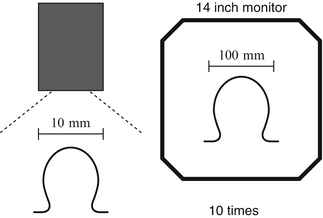(1)
Department of Endoscopy, Fukuoka University Chikushi Hospital, Fukuoka, Chikushino, Japan
Abstract
The 1990s were a boom time for magnifying colonoscopy, with a succession of reports along the lines “On examining the pit pattern with a magnifying colonoscope at 100× magnification….” However, magnification is relative, and I remember feeling a vague sense of unease at the use of the term magnification.
At the 2000 Endoscopy Forum Japan (EFJ), I asked Mr Hisao Yabe, an engineer with Olympus Medical Systems Corp., to make a presentation easily understandable by endoscopists, regarding the difference between an endoscope’s magnifying ratio and resolution. Mr Yabe was kind enough to lend me some of the slides he used in that presentation, and here I will present some extracts from his paper, along with some thoughts of my own, in a simple explanation of the difference between magnifying ratio and resolution in an electronic endoscopic system.
Definitions of magnifying ratio and resolution, and the systems of measurement and notation, vary between electronic equipment manufacturers, so this should be considered no more than a rough guide.
Keywords
CapillaryElectronic endoscopy systemMagnifying endoscopyMagnifying ratioResolution3.1 Definition of Magnifying Ratio
In an electronic endoscopy system, there is no concept of an absolute magnifying ratio, and it is no more than a relative parameter. In practice, as in Fig. 3.1, when a polyp with an actual diameter of 10 mm is displayed on a 14 in. monitor as 100 mm in size, the display reads “10× electronic endoscopy magnifying ratio.” If the same 10 mm diameter polyp is displayed on a 28 in. monitor as 200 mm in size, or twice as big, the display will read “20× electronic endoscopy magnifying ratio.” Accordingly, when recording the magnifying ratio, we need to make clear the conditions, or what size monitor was being used, at the time.
In my experience, the maximal magnifying ratio of the GIF-Q240Z is listed as 80× in the Japanese product catalogue and 115× in the UK. This is because the standard Japanese package includes a 14 in. monitor, whereas overseas they get a 20 in. monitor to go with their more spacious endoscopy theaters. The calculation is as follows:


3.2 Definition of Maximal Magnifying Ratio
It goes without saying that the magnifying ratio changes according to the distance between the endoscope tip and the object. In practice, even looking at the same object, if the distance between endoscope tip and the object decreases, the object will appear larger on the monitor screen, increasing the magnifying ratio. Conversely, if the distance between endoscope tip and the object increases, the magnifying ratio decreases.
Considering the above, the maximal magnifying ratio is defined as “the magnifying ratio measured when the endoscope has been brought as close as possible to the object while staying in focus, just before going out of focus.”
< div class='tao-gold-member'>
Only gold members can continue reading. Log In or Register to continue
Stay updated, free articles. Join our Telegram channel

Full access? Get Clinical Tree








